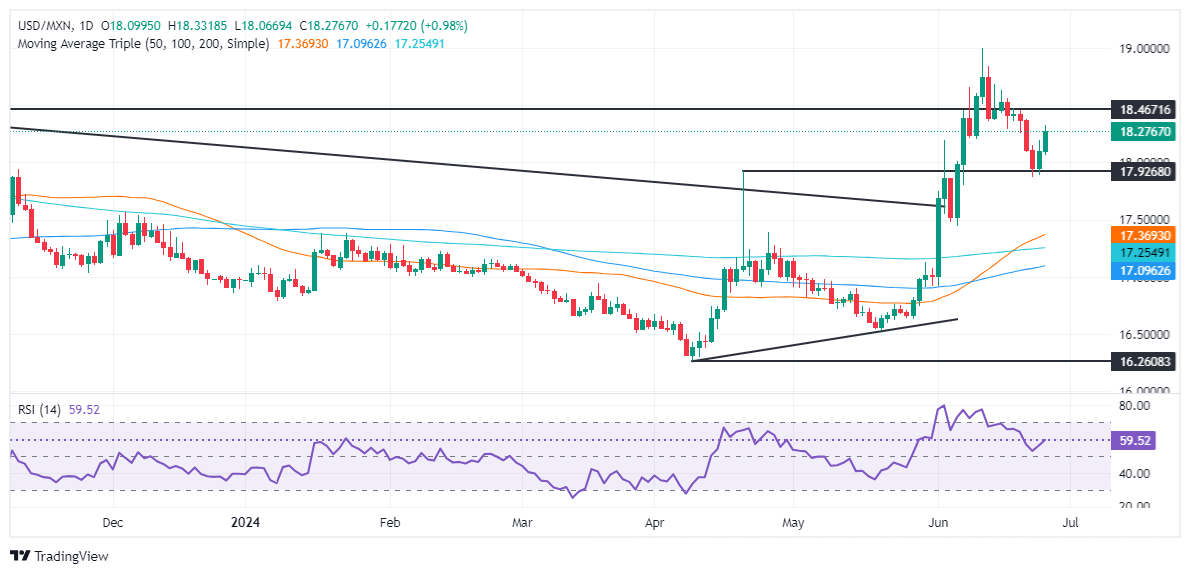Mexican Peso extends losses ahead of Banxico’s meeting
- Mexican Peso falls for second consecutive day against US Dollar.
- USD/MXN hits a daily high of 18.33 before trimming gains as Wall Street turns green.
- Banxico expected to keep interest rates unchanged at 11.00% amid sharp Peso depreciation and recent inflation spike.
- Fed Governor Michelle Bowman's hawkish comments support USD.
The Mexican Peso extended its losses for the second consecutive day against the Greenback after the latter rose sharply. This was boosted by the jump in the USD/JPY pair, which exchanges hands at 38-year high as US Treasury bond yields advance as traders brace for the release of crucial inflation data in the United States (US). The USD/MXN trades at 18.23, up 0.73%.
Sentiment shifted positively as Wall Street turned green during the last hour, trimming the USD/MXM pair gains after hitting a daily high of 18.33. Mexico’s economic docket remains scarce as investors brace for Thursday's Bank of Mexico (Banxico) monetary policy.
Banxico is expected to keep interest rates unchanged at 11.00% after the Mexican currency experienced a sharp depreciation following the June 2 election, alongside the sudden jump in June’s mid-month inflation.
The Citibanamex survey showed that most economists expect rates to be unchanged at 11.00%, yet they expect the central bank to cut rates until August.
Besides that, investors are eyeing President-elect Claudia Sheinbaum’s cabinet members on Thursday.
Meanwhile, the USD/MXN experienced back-to-back positive gains sponsored by Federal Reserve (Fed) officials' hawkish comments, particularly Governor Michelle Bowman. She said that rates will remain steady for “some time” and that if the disinflation process stalls, she’s open to another interest rate hike.
Daily digest market movers: Mexican Peso falls as traders await Banxico decision
- Mexico’s economic docket will feature the Balance of Trade for May on Thursday, alongside the Unemployment Rate.
- Citibanamex survey showed economists priced out fewer rate cuts by the central bank, estimating rates will be lowered to 10.25% in 2024, up from 10.00%. Regarding the USD/MXN, the consensus estimates the exchange rate will end the year at 18.70, up from 18.00 in the previous report.
- Regarding economic growth, the consensus revised the Gross Domestic Product (GDP) for 2024 downward from 2.2% to 2.1% YoY.
- CME FedWatch Tool shows odds for a 25-basis-point Fed rate cut at 56.3%, lower than Tuesday’s 59.5%.
Technical analysis: Mexican Peso falls as USD/MXN rallies back above 18.20
The USD/MXN uptrend remains in play, but the exotic pair will remain volatile during the rest of the session and Thursday as traders await Banxico’s decision. Momentum favors buyers, according to the Relative Strength Index (RSI), is bullish.
For a bullish continuation, buyers need to push the USD/MXN exchange rate past the psychological 18.50 level. Once cleared, the next stop would be the year-to-date (YTD) high of 18.99, followed by the March 20, 2023, high of 19.23, followed by an uptick to 19.50.
On the flip side, if USD/MXN tumbles below 18.00, the next key support level would be the 50-day Simple Moving Average (SMA) at 17.37 before testing the 200-day SMA at 17.23. Once those two levels are cleared, the next stop would be the 100-day SMA at 17.06.

Mexican Peso FAQs
The Mexican Peso (MXN) is the most traded currency among its Latin American peers. Its value is broadly determined by the performance of the Mexican economy, the country’s central bank’s policy, the amount of foreign investment in the country and even the levels of remittances sent by Mexicans who live abroad, particularly in the United States. Geopolitical trends can also move MXN: for example, the process of nearshoring – or the decision by some firms to relocate manufacturing capacity and supply chains closer to their home countries – is also seen as a catalyst for the Mexican currency as the country is considered a key manufacturing hub in the American continent. Another catalyst for MXN is Oil prices as Mexico is a key exporter of the commodity.
The main objective of Mexico’s central bank, also known as Banxico, is to maintain inflation at low and stable levels (at or close to its target of 3%, the midpoint in a tolerance band of between 2% and 4%). To this end, the bank sets an appropriate level of interest rates. When inflation is too high, Banxico will attempt to tame it by raising interest rates, making it more expensive for households and businesses to borrow money, thus cooling demand and the overall economy. Higher interest rates are generally positive for the Mexican Peso (MXN) as they lead to higher yields, making the country a more attractive place for investors. On the contrary, lower interest rates tend to weaken MXN.
Macroeconomic data releases are key to assess the state of the economy and can have an impact on the Mexican Peso (MXN) valuation. A strong Mexican economy, based on high economic growth, low unemployment and high confidence is good for MXN. Not only does it attract more foreign investment but it may encourage the Bank of Mexico (Banxico) to increase interest rates, particularly if this strength comes together with elevated inflation. However, if economic data is weak, MXN is likely to depreciate.
As an emerging-market currency, the Mexican Peso (MXN) tends to strive during risk-on periods, or when investors perceive that broader market risks are low and thus are eager to engage with investments that carry a higher risk. Conversely, MXN tends to weaken at times of market turbulence or economic uncertainty as investors tend to sell higher-risk assets and flee to the more-stable safe havens.



